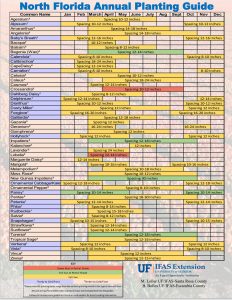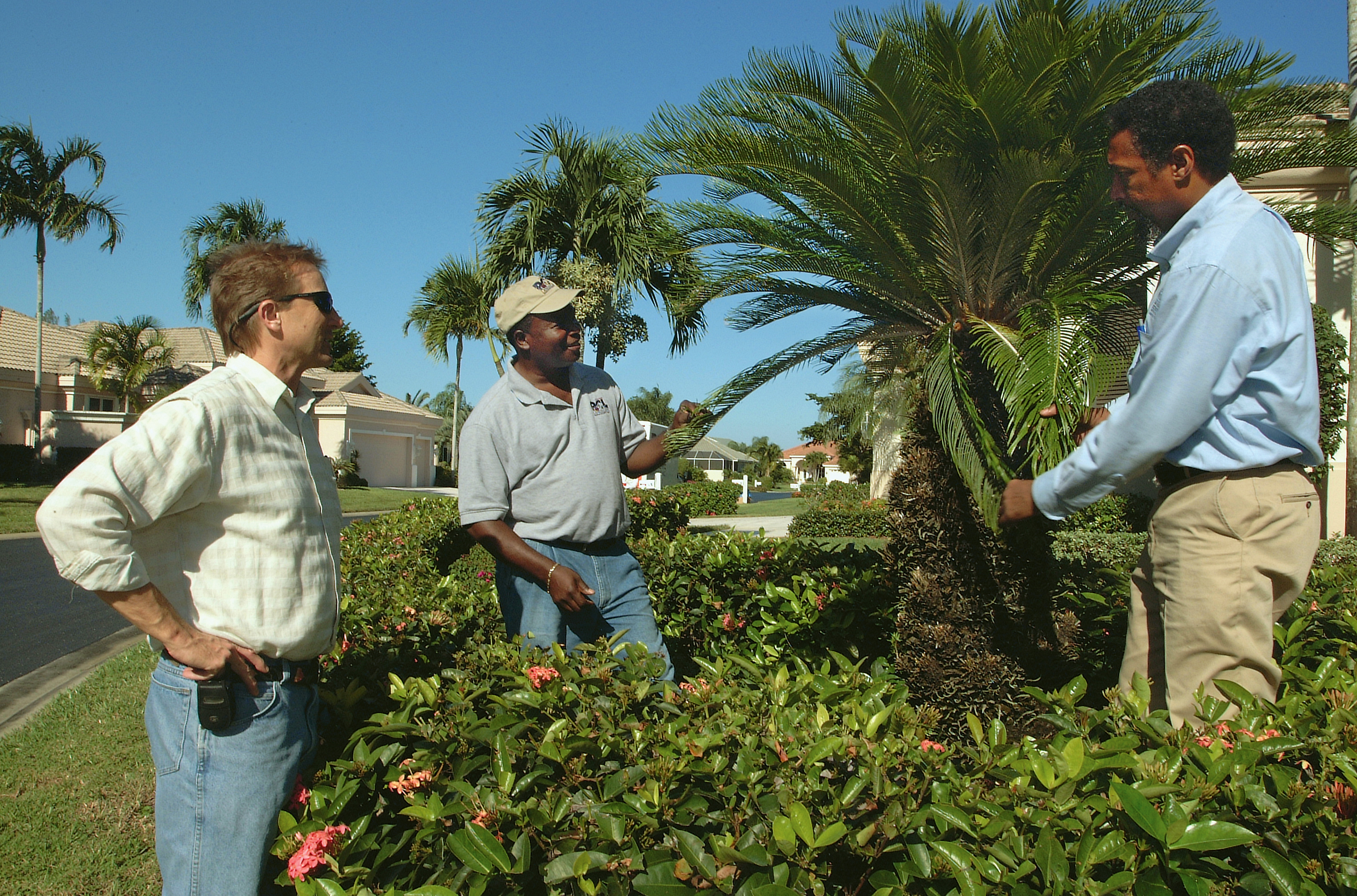
by Matt Lollar | May 28, 2025
Gardening just wouldn’t be any fun without the pests. In this episode of Gardening in the Panhandle LIVE!, the hosts answered some very important questions about different types of pests in Florida lawns and landscapes. Before we talk about some of the specific topics from this episode, it’s critical to know the definition of a pest when it pertains to our yards. A pest is any organism that is harmful and/or damaging to humans or the property of humans such as crops and livestock. Weeds are pests, some insects are pests, and diseases are pests.
Integrated Pest Management or IPM for short is the use of different pest management strategies to help control pests. The UF/IFAS Publication Landscape Integrated Pest Management provides more details on the steps involved in a good IPM program.
As stated above, pests can come in a lot of forms. Pesticides offer control for some pests. The article The Basics of Pesticides provides more information on using pesticides.
“Natural” can be a vague term. You’ll want to read the UF/IFAS publication Natural Products for Managing Landscape and Garden Pests in Florida to help clarify the definition of natural pesticides and offer some natural control options.
If you’re growing edible crops, then you’ll need to follow some extra precautions to make sure your crops are safe to eat. A Florida-Friendly Landscaping Approach to Pest Management in Your Edible Landscape provides IPM strategies specific to fruits, vegetables, and herbs utilized in the landscape.
Some annual weeds are easier to control as the germinate. Pre-emergent herbicides provide a barrier that kills most annual weeds shortly after they germinate. Apply pre-emergent herbicides in late winter before day temperatures reach 65°F–70°F for 4 or 5 consecutive days and in the fall when nighttime temperatures drop to 55°F–60°F for several consecutive days.
The first step of IPM is to scout for pests. More information on scouting can be found in the article Scouting: The tip of the IPM spear from Matt Smith with the UF/IFAS Extension in Lake County.
The larva of many beetle species like to eat turfgrass roots. More information on June beetles and their control can be found in the fact sheet June Beetles (White Grubs).
Ground pearls are very difficult to control. The UF/IFAS publication Ground Pearls, Margarodes spp. (Insecta: Hemiptera: Margarodidae offers detailed information of these underground relatives of armored scales.
Snakes usually help us control pests around our homes. If you’re interested in what snake species live in Florida, then you’ll want to read the UF/IFAS publication Managing Conflicts with Wildlife: Living with Snakes.
Chinch bugs are a major insect pest of Saint Augustinegrass. The UF/IFAS publication Southern Chinch Bug, Blissus insularis Barber (Insecta: Hemiptera: Blissidae) provides some valuable information on this insect pest and how to control it.
Fire ants are a direct pest of humans and the create some unsightly mounds in the yard. A number of baits are available on the market to help keep them out of the landscape. The article Sustainable Fire Ant Control offers more details on baits and other fire ant control strategies.
Mole crickets are another type of insect that feed on turfgrass roots. The Mole Cricket IPM Guide for Florida is a great place to start if you’re trying to understand this pest better.
If you’re sticking with an edible landscape theme, then you’ve certainly encountered leaf-footed bugs and stinkbugs on your fruit and vegetable crops. Larry Williams with the UF/IFAS Extension in Okaloosa County has written a very informative article on leaf-footed bugs titled Leaf-footed Bugs Are Common On Tomatoes.
The extension publication Weed Management Guide for Florida Lawns offers a variety of weed management strategies for your yard.
Weed control in plant beds can sometimes be tricky. The UF/IFAS publication Improving Weed Control in Landscape Planting Beds provides solutions for managing weeds around shrubs and ornamentals.
Products containing glyphosate are good for spot spray applications in the landscape, however some people may choose to avoid its use. The UF/IFAS publication Use of Glyphosate and Herbicide Alternatives for Weed Control in Florida Landscape Planting Beds discusses the advantages and disadvantages of using glyphosate and other herbicides.
Pests can wreak havoc on healthy lawns and landscapes. The resources and advice provided in this episode of Gardening in the Panhandle LIVE! will help you maintain a beautiful setting to enjoy. To view this episode of Gardening in the Panhandle LIVE! please visit our YouTube channel.
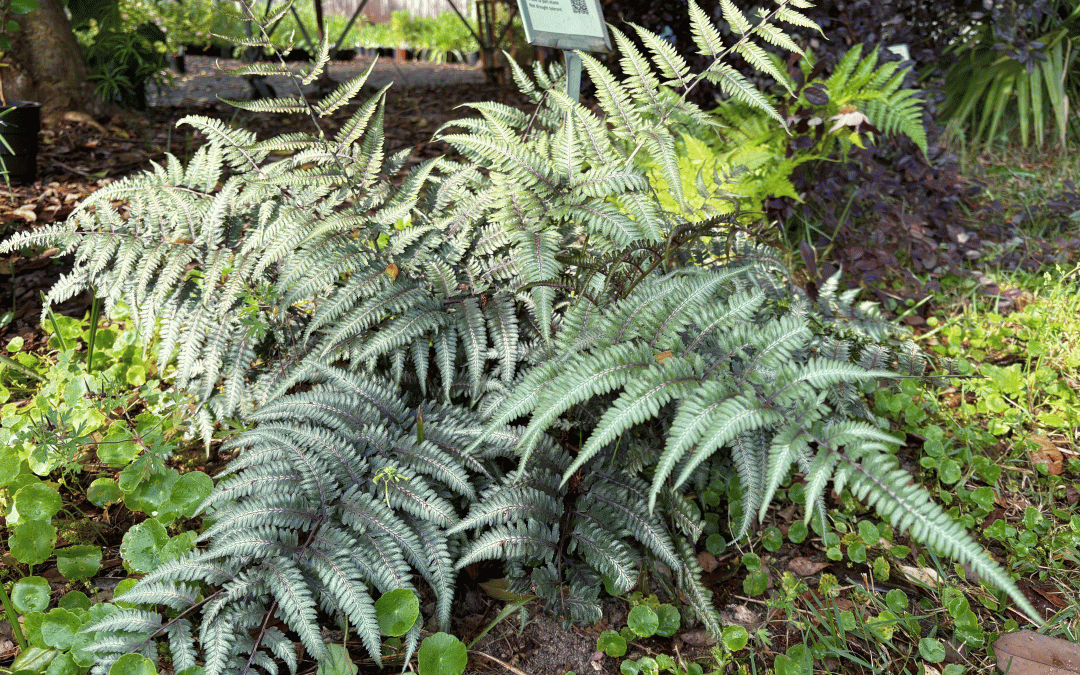
by Matt Lollar | Apr 30, 2025
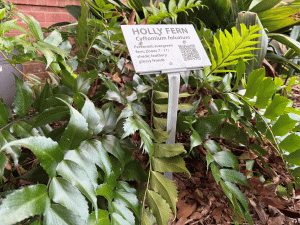
A holly fern in the landscape. Photo Credit: Matt Lollar, University of Florida/IFAS Extension – Santa Rosa County
On a recent episode of Celebrity Jeopardy, one of the categories featured answers all about ferns. The category got me thinking about all the confusing things about ferns.
First of all, are ferns even plants at all? Yes, but there are some unique characteristics that make them stand out. Ferns are vascular plants like most all of our other landscape and house plants, but they do not produce flowers, fruits, and seeds like other vascular plants. Instead, they produce spores in small, round structures called sporangia that are usually on the undersides of leaves. Sporangia are also found on fungi and algae.
A pretty noticeable feature about ferns is their leaves. Fern leaves are called fronds which consist of many small leaflets called pinnae. Fronds have a feather-like appearance that give most ferns a fine texture that softens the landscape. Sterile, non-spore producing fronds called fiddleheads develop from the center of the plants in early spring. They are called fiddleheads because they are curled like the top of a fiddle when they first emerge. The fiddleheads of some fern species are prized by chefs for their delicate flavor and crunchy texture. Fertile, spore producing fronds develop later in the season.
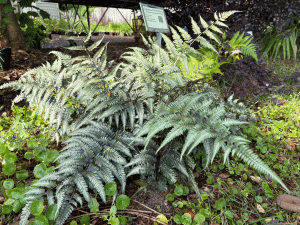
A Japanese painted fern in the landscape. Photo Credit: Matt Lollar, University of Florida/IFAS Extension – Santa Rosa County
When grown outdoors, most ferns do best in spots that receive filtered light or a bit more shade. However, some species of ferns that are grown indoors may need a little more light. Ferns like high humidity environments which is why we usually see them growing in floodplains and in wetlands in the wild. Indoor ferns should be watered thoroughly whenever the soil surface begins to feel dry. Choose potting soils with a high percentage of peat moss for its moisture retaining properties. And make sure you don’t over-fertilize.
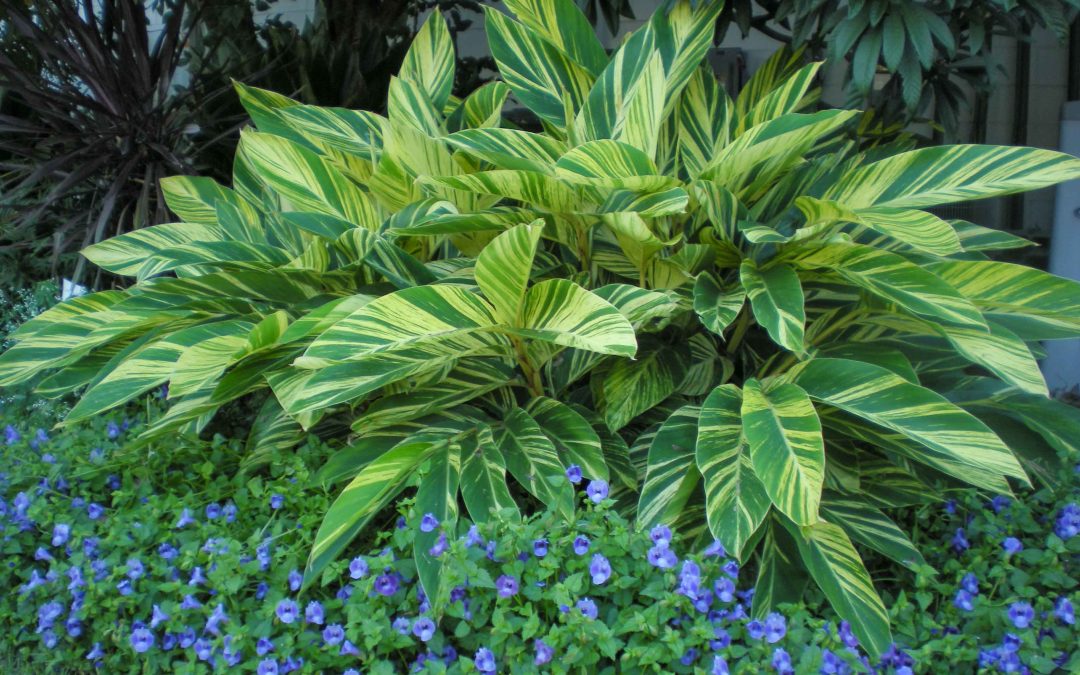
by Matt Lollar | Apr 30, 2025
If you’re going for a tropical look, but don’t want to lose your landscape, then you’ll get some great ideas from this episode of “Gardening in the Panhandle LIVE!”.
Most of the Florida Panhandle falls within USDA Plant Hardiness Zone 9a. The USDA Plant Hardiness Zone Map displays the average annual extreme minimum winter temperature for locations throughout the United States. Based on NOAA weather data, the date of the last spring freeze can range from February 16 to March 15 depending on location in the Florida Panhandle. It’s important to note these figures are based on averages and will vary from year to year.
Some plants need protection from freeze events. More information on protecting plants from cold weather can be found in the article “Preparing the Landscape for Cold Weather”.
There are quite a few native plants that can give your landscape a tropical look. Plants that have a tropical look usually have bright flowers, variegated leaves, and/or coarse textured foliage. A native that comes to mind is Florida anise that grows well in shaded areas and is available in varieties with variegated foliage and light green foliage. The native firebush (Hamelia patens) will freeze back some years, but provides a tropical focal point with its showy flowers and unique foliage. Some oakleaf hydrangea selections with chartreuse colored blooms can also provide a tropical aspect.
Other plants that give a tropical feel, but aren’t native to Florida include cast iron plant, canna lilies, red hot poker, fatsia, farfugium, holly fern, African false hosta, and loquat trees. Some tropicals that freeze back, but will come back in the spring include ornamental gingers and tumeric. To view other suitable plants for the Florida Panhandle check out the Florida-Friendly Landscaping Plant Guide.
Row covers and frost cloths can provide some insulation for sensitive plants. The thickness of the material used can vary significantly and offer different levels of freeze protection. It’s important the material covers the plants all the way to the ground, not just the foliage. More information on row covers in the article “Using Row Covers in the Garden” from the University of New Hampshire.
It’s important to wait to clean up and prune freeze damaged plants. Mid-to-late March is a good time to cut back plants that have been damaged from a freeze event. However, the longer you wait the better. More information for caring for these plants can be found in the article “Treating Cold-Damaged Plants”.
Coastal climates differ from mainland environments. In the winter, temperatures in these two places will be similar, but windchills may be exaggerated in coastal areas. Additional wind tends to dry plants out faster, but spots near water may allow for some experimentation with more tropical plant material.
For more ideas on plant selections for the Florida Panhandle, check out other Gardening in the Panhandle articles or contact your local Extension Office. The “Freeze Friendly Foliage Plants” episode of Gardening in the Panhandle LIVE! can be found at 2025 Gardening in the Panhandle LIVE! Freeze Friendly Foliage. Visit the NWD IFAS YouTube page to view additional episodes of Gardening in the Panhandle LIVE!

by Matt Lollar | Mar 13, 2025
Attracting wildlife is one of the Florida Friendly Landscaping principles. However, some species are better observed from long distance. Deer are beautiful creatures and taste pretty good too, but they can wreak havoc to a landscape and to fruits and vegetables. There are a number of methods to deter deer, but you’ll need to keep them guessing to limit damage to your yard.
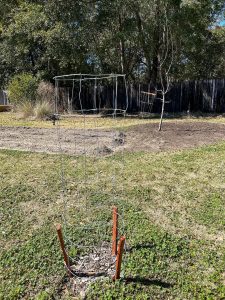
A plant cage formed from metal fencing. Photo Credit: Matt Lollar, UF/IFAS Extension – Santa Rosa County
Physical Barriers – This deterrent method may be the most effective if installed correctly, but it can also be costly and requires the most labor and engineering to install.
- Temporary Deer Fencing – Plastic mesh fencing can temporarily keep deer away from plantings. This material can be draped over plants or attached to posts or fencing with plastic ties or wire.
- Hardware Cloth and Seedling Tubing – Hardware cloth can be formed into different shapes or secured to small structures to form a barrier around small plants. UV-inhibited polyethylene and polypropylene mesh seedling tubes can be bent into cylinders and placed around young shrubs and trees to protect them from foraging deer and other wildlife.
- Garden Fencing – There are a variety of gauges available for this fencing. Heavier gauges are recommended to help keep deer out. It’s important to note that most adult deer can jump 7 feet high, so a fence height of at least 8 feet is recommended.
- Electric Fencing – Peanut butter can be spread on a single strand of electric wire to encourage deer to check it out. More permanent electric fences can be installed, but are significantly more expensive.
Scare Items – Deer are skittish to things that are unfamiliar to them. However, it doesn’t take them long to adapt.
- Ribbons and Tape – Light-weight ribbons and tape fluttering in the wind can help deter deer. Holographic and iridescent foil materials have shown the best results because they reflect sunlight and create more noise in the wind.
- Motion Activated Sprinklers – Hitting a deer directly and the sound of water being turned on are deterrents for deer and other wildlife. It is best to periodically move the location of these sprinklers to improve their effectiveness.
- Noisemakers – Whistles, firecrackers, and propane cannons can annoy deer, and people too. Unfortunately, deer become accustomed to these tactics. It is best to use noisemakers in combination with other deterrent methods.
- Dogs – Just having a dog around can help keep deer away. Even if it’s a dog that has no care to bark at or chase a deer, its scent alone may be enough to deter them.
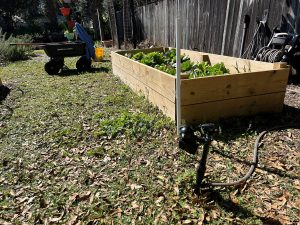
A motion activated sprinkler used to deter wildlife from a raised bed garden. Photo Credit: Matt Lollar, UF/IFAS Extension – Santa Rosa County
Chemical Repellents – A plethora of chemicals are marketed as deer deterrents. These products can work as odors, create bad tastes, or incite fear. Common ingredients include capsaicin, predator urine, egg solids, garlic, and soap. A number of factors can contribute to the effectiveness of chemical repellents including the growth stage of the plants to be protected and frequency of reapplication,
Resistant Plants – Deer eat almost anything. They sometimes even eat so-called “deer resistant plants”. However, the plants listed below are less desirable to deer. For a more comprehensive list of plant susceptibility to deer damage please visit the archived publication “Ornamental plant susceptibility to damage by deer in Florida”.
- Trees – Deer will rub on almost any tree, but a few they are less likely to eat include: bottlebrush, sabal palm, crape myrtle, edible fig, loquat, live oak, magnolia, and yaupon holly.
- Shrubs – Some shrubs that deer are less likely to eat include: mahonia, viburnum, wax myrtle, juniper, and most evergreen azaleas.
- Annuals and Perennials – There are quite a few annuals and perennials that have shown signs of resistance to deer including: black-eyed Susan, bush daisy, cone flower, dusty miller, marigold, and salvia.
More detailed information on wildlife deterrents can be found in the publication “How to Use Deterrents to Stop Damage Caused by Nuisance Wildlife in Your Yard”.
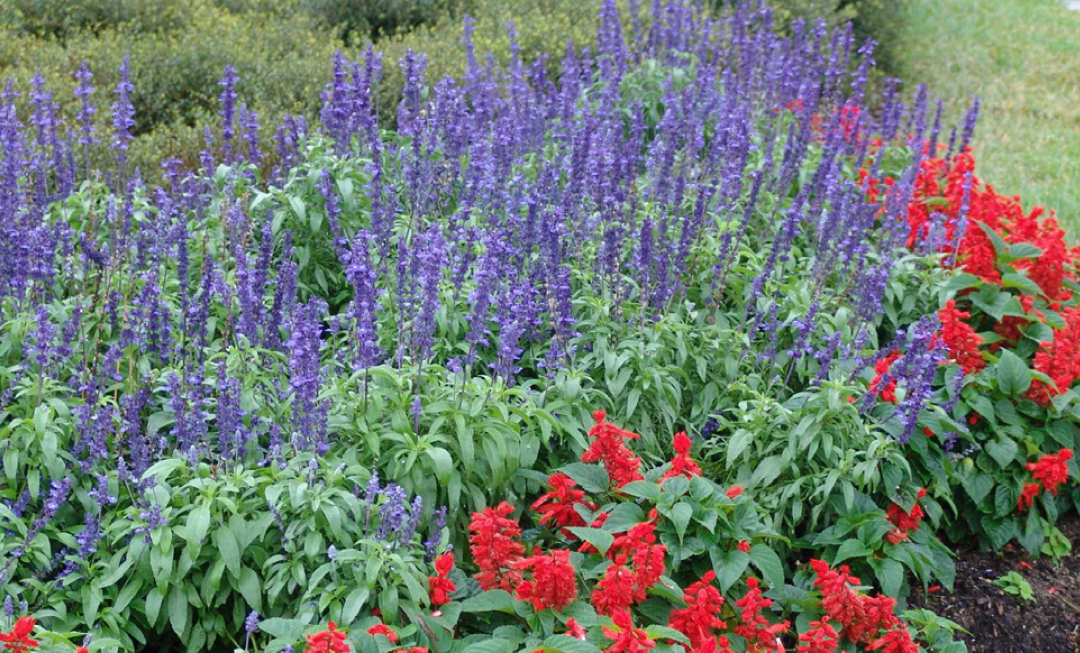
by Matt Lollar | Jan 30, 2025
Planting annuals is a great way to add color and texture to the landscape. Annuals can provide an added visual component to the garden regardless of if they’re planted in the ground or in containers, or even better—both. An annual plant completes its life cycle (growing, flowering, seed set, and death) in a single growing season. Annuals can stay in good health and last longer if they are pruned back when they get leggy and by pinching off any fading flowers (deadheading). To help plan your garden beds and container plantings please click below to enlarge the image of the handy “North Florida Annual Planting Guide”. Please note the suggested planted dates in this guide are based on average monthly temperatures, but every year is different. Some years we may have a late frost around Easter, other years we won’t have a cold front after February.
